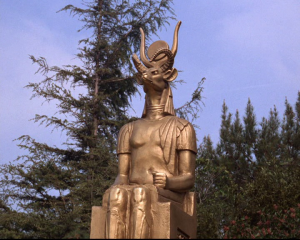Batman ’66: The Curse of Tut/The Pharaoh’s in a Rut
December 4th, 2015
What’s The Story?
A giant “sphinx” is brought into Gotham Central Park by gangsters dressed in golden, bearded, masks. It announces that the “great king of the Nile” has come back from the dead, and that he will be taking over Gotham.
The police at first think that this is a publicity stunt for the new exhibition of Egyptian antiquities at the museum. When they discover it isn’t, there’s only one explanation — it’s the work of the nefarious King Tut!
After Batman doesn’t fall for a death-trap in the “sphinx”, King Tut replaces the mummified remains of King Tutankhamun with himself, and is found there at the press launch of the exhibition. Everyone just assumes that Tutankhamun survived death, the mummification process, and several thousand years interment, and Tut is taken off to hospital on a stretcher, but the bearers are secretly in Tut’s gang, and gas Bruce Wayne and kidnap him.
He escapes, but then gets himself kidnapped again, and escapes again. Tut steals the Batmobile, and accidentally sets off the ejector seat, hitting himself on the head and restoring his original personality — he had been an Egyptology professor at Yale before getting hit on the head once before had turned him into a mad criminal.
The Goodies
Batman
Believes that King Tut is to be pitied, although it should be “Pity, Commissioner, tempered with caution. Our first aim is to thwart his criminal plans.”
Has a bizarrely patchy interest in Egyptology. He can identify a generic-looking Egyptian costume as being specifically fourteenth dynasty, but thinks that was Tutankhamun’s dynasty (he was eighteenth). He also claims that the “sphinx” in the park is “a rather good imitation of the fourth dynasty Sphinx at Giza”. The Sphinx at Giza is the one you think of when you think of the Sphinx — the one by the pyramids with no nose. The statue that everyone in Gotham calls a sphinx isn’t a sphinx at all, but rather a statue of a ram-headed god, either Amun-Ra or Khnum. He also believes that Egyptian supercriminals always struck at 6PM, or “oda wobba simba”, the hour of the hyena in the fourteenth dynasty.
However, he does admit there are gaps in his knowledge. When Robin asks if there’s anything he doesn’t know, he replies “Oh yes, Robin. Several things, in fact.”
He’s capable of surviving pebble torture (like water torture, but with pebbles) by reciting the multiplication table backwards, and of dancing the Batusi afterward.
Believes that one must learn that machines made by human hand are not infallible.
Robin
Has no driving license. Epithets used “Holy hieroglyphics!”, “Holy hurricane!”, “Holy whiskers! That was a close shave!”, “Holy masquerade!”, “Holy asp!”, “Holy travel agent!”, “Holy Hi-fi!”, “Holy smoke!”, “Holy skyrocket!”, and, rather uncharacteristically, “what the heck?”
The Baddies
King Tut
A Yale professor of Egyptology who became convinced he was the reincarnation of Tutankhamun (or “King Tut” as the Pharaoh is only ever referred to here), that Gotham is the modern Thebes, and that he deserved to be its ruler, after being hit on the head during a student riot.
King Tut’s Gangsters
A bunch of nondescript goons, along with two advisors, the Grand Vizier and the Royal Scrivener, who have the now-traditional “the boss is screwy but he comes up with good plans” dialogue.
Nefertiti
A beautiful young woman, one of several in King Tut’s harem. Her voice is used in the “sphinx’s” proclamations, but she loses favour with Tut after saying of Batman “he turns me on!” and “He’s so handsome and clean cut and groovy”. She suffers the pebble torture, but doesn’t cope as well as Batman and is reduced to a wreck.
The Gadgets
Very little in the way of gadgets in this one. Just an asp bracelet that explodes when thrown.
The Batmobile
Has a “batbeam” which can be used to destroy things from a distance. Can be controlled by a “voice control Batmobile relay circuit” — Batman phoning the Batcave, which relays the signal on to the Batmobile. However, the control isn’t perfect.
What’s New?
Now the stories are no longer being based on comics, King Tut is the first villain to be created in a totally new story (the only other villain created for the TV show to this point, Zelda, took the place of a male magician from the original comic on which that story was based).
Review
And again we have a story that is, at least mildly, commenting on current events.
Chief O’Brien’s mention of the National Guard being used to destroy the “sphinx”, early on, is the first thing to note. The National Guard ( a military reserve force, much like Britain’s Territorial Army) were on people’s minds a lot in the mid-sixties. In both New York State and California, the National Guard had been called in to help put down demonstrations in the previous two years.
Those demonstrations, which we touched on in the last review, were part of a wider sense of unrest in the USA in the 1960s. The Civil Rights movement was finally starting to make some headway, with black people finally being granted equal legal rights and de jure segregation being ended (although there is still, even fifty years later, a long way to go before de facto segregation, and systemic discrimination against black people, actually end), and the violent pushback against this from whites in turn caused black people to demonstrate, with those demonstrations themselves being met with institutional violence.
Meanwhile, many of the white, liberal, college students who had supported the civil rights movement were themselves becoming radicalised by a threat to their own lives — the Vietnam War. And this is where King Tut’s bump on the head comes in.
While Tut was a professor at Yale, where violent demonstrations were incredibly unlikely (this was the joke), there were a large number of demonstrations at the University of California Berkeley that had ended in the involvement of the police. These demonstrations were originally about the right to free speech on the college campus, where members of a civil rights group called the Congress of Racial Equality were banned from political activism under a rule that said only the college Democratic and Republican clubs were allowed to campaign on campus. CORE’s cause was taken up by a left-wing group of Berkeley students, SLATE and, in a pattern that will be familiar to anyone who has ever been involved in a political cause that attracts the hard left, the initial civil rights cause soon expanded to take in first free speech and then the Vietnam war, with the campaign ending up primarily as an anti-war one.
These student demonstrations (which involved many arrests, and the occupation of parts of the university) were profoundly disturbing to many at the time, and were soon to spread throughout the US, though at the time this episode was made Berkeley was the only university to have had demonstrations in any great number. In most cases, they were nothing more than normal political activity, but (as Micky Dolenz of the Monkees put it in their own show around this time) “a lot of people and journalists don’t know how to spell ‘demonstration’, so they use the word ‘riot’ because it only has four letters”.
And these “riots” are what has caused King Tut to go from being someone engaged in academia to becoming a disruptive force attempting to subvert and destroy the legitimate government, just as those students were seen. While Batman is at least in part aimed at the counterculture, the show can’t, ultimately, be sympathetic to it. The best it can offer the counterculture is pity, tempered with caution.
Personnel
Cast
Adam West: Batman
Burt Ward: Robin
Victor Buono: King Tut
Alan Napier: Alfred
Neil Hamilton: Commissioner Gordon
William Dozier: Narrator
Crew
William Dozier: Executive Producer/Creator
Robert C Dennis and Earl Barratt : Writers
Charles Rondeau: Director
These posts should now be back on a weekly schedule. However regular or irregular they are, though, the people who back my Patreon will always get them three posts ahead. Why not be one of them?





Leave a Reply
You must be logged in to post a comment.